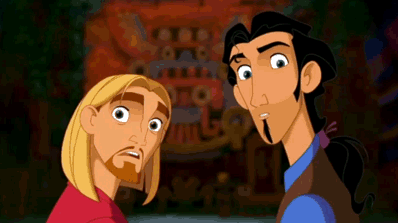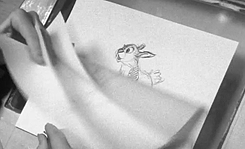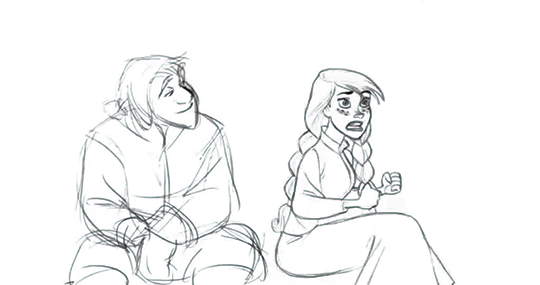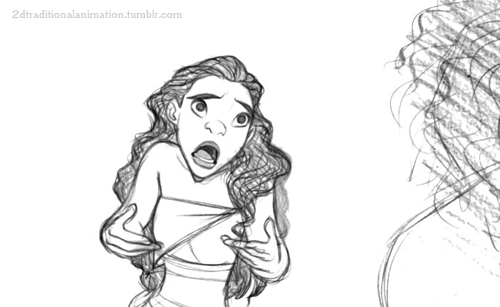In the field of animation, the technological age has certainly revolutionized the process one takes to bring a cartoon to life. With drawing tablets, art specific software, and the whole process of 3D modeling, animation has in fact become a quicker and easier process than the days of tracing paper and angled tables. It used to be that someone would draw each individual frame for animated films and tv shows, and while that time seems to have passed from modern animated films, I’ve always appreciated the traditional 2D animated films that I ended up growing up with.



The Prince of Egypt, Road to El Dorado, Treasure Planet, Tarzan, the list goes on. The various styles had a fluidity and colorful spirited feel that spoke directly to me as a child and that still speaks to me today, partly out of nostalgia and partly out of my current appreciation for the process of those films. The typical traditional animation in its prime ran at about 24 frames per second, aka 24 drawings per second. That means that just a single minute of animation can be up to 1,400 separate pieces of paper, each with a unique drawing plastered on its surface. Now take that and multiply it by 90, and you have a feature length film. How does one person do all of this you may ask? Well the answer is that they don’t. Animation teams are responsible for the magic that appears on the silver screen and they are enormous. There are people for specific characters, for the fluidity of those same characters, for backgrounds, for vehicles, for buildings, for just about everything that you see on screen. Animation was once hand crafted frame by frame, and I think if more people appreciated the grueling process that these artists go through, the genre of animation can get more respect and appreciation as a whole.

Lets start with the basics. Every animation starts out the same way any other film starts, with a storyboard. Storyboards are almost like extremely rough comics that allow the artists to get an idea of the angles and position of the scenes and characters to base the final product off of. Storyboards while they seem rough and quick can be just as tedious of a process, as where many animators have to only focus on one aspect out the whole project, storyboard artists have to take everything into account when composing what essentially are the schematics of the animated film from start to finish.


Next there’s the animatic phase of the process. An animatic is very similar to a storyboard, but with slight differences. Animatics usually are drawn up after the recording of voices and other sound effects, and unlike the storyboard, it is presented in more like a film than a comic. An animatic often expresses what the main animators will see as what they call the key frames of the film. But that just begs the question, what’s a key frame? Well imagine you wanted to animate someone standing up out of a chair, the key frames in that animation would be the basic, most noticeable positions of the person standing to get an overall idea of what’s happening. In this case it would mostly likely be a key frame of the person in the chair, the person beginning to stand, then the person standing. Frames like these and the basic idea of what they project is the core idea of what an animatic should be. Some animatics even include small snippets of fully animated movements like you would see in the final product to really sell a specific motion.



After what can be seen as the preparation phase, the animation begins. Those key frames I mentioned earlier are drawn in, making sure they all stay consistent with the movements of the character or whatever is being animated using tracing paper. The key frames played in a film format still look animated, but more choppy and less fluid than it would be if not for this next step. After the key frames are finished, they are handed off to more artists who give the animation that flourish that makes them so pleasing to the eye, the in-betweens. These are the frames that take place in between the key frames and really establish the movement aspect of animation and how they look so fluid. In my opinion, the artists responsible for this part of the process are the MVPs. They easily have to do the most work in the whole thing, also accounting for things to make animation more fluid, like exaggerating features in the middle of movements or stretching certain characteristics for the same reason. In fact, sometimes these exaggerations look rather ridiculous on their own, but when played at the proper speed, it creates an effect that is ultimately pleasing to the eye and cohesive in the grand scheme of the movement being animated.



Of course after this there’s the inking and the coloring all done by separate artists, which is a ton of work in their own rights, but for this blog I mainly wanted to focus on the beginning and largest parts of the animation process to really share the understanding of the work put into these “cartoons” as some people only know them.
Animation is an art form that has been perfected over nearly a century, and while it has evolved past, what I’ve always seen as, perfection in light of technological advances, I will still always have an appreciation for the old style and hard work put into the traditional animation I grew up with and would still like to see more of today. It was this appreciation that inspired me to want to pursue animation myself and its an appreciation that I hope will spread even in our current age of CGI.





I love all of the images and gifs you included, they provide excellent examples (and are really fun to look at/watch). I have certainly gained an appreciation for the creators of older animated films after reading this post- what an incredible amount of work! However, I agree that this makes them very special and unique. I would love for this style of animated filmmaking to grow popular again because it adds such an individualized element to the story being told. CGI is pretty great, but I’ve noticed more and more lately than all of these more recent animated films look exactly the same (the characters in Tangled look nearly identical in design to those in Frozen). I think movies having unique designs is something that should be much more valued, even if it’s not the fastest production choice.
While reading this post, I couldn’t help, but think about how difficult it is to maintain the smoothness of animations. Everyone has their own drawing style which means that, a team of animators could have very different animations. In order to make the animations look fluid, the team must all have the same drawing style which is a difficult task. Also, it must be difficult to maintain the style of animation throughout the entire film being that the animation is down by a team rather than one single drawer. This post really made me appreciate the work of art that goes into older animated films.
Excellent work. About traditional animation explained fabulously. Nice gif attached with explanation
The girls